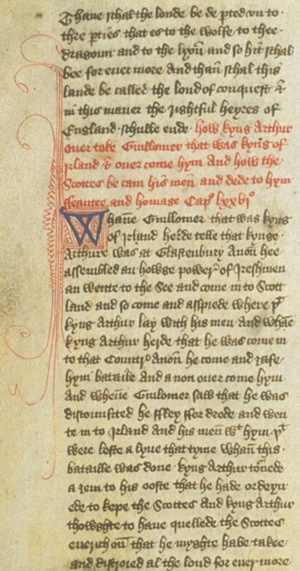
An Arthurian Chronology
Siân Echard, University of British Columbia
September 2020: This page has been moved to a new location (September 2020: This page has been moved to a new location (https://sianechard.ca/web-pages/an-arthurian-chronology/), and is no longer being maintained here. Eventually all my pages from this site will move to their new home at my domain, but it will take quite a while for the migration to be complete. As each page moves, I will add this message to it. The pages should continue to function on their old server, with their old URLs, for the foreseeable future: I will not take them down until all my pages have migrated.), and is no longer being maintained here. Eventually all my pages from this site will move to their new home at my domain, but it will take quite a while for the migration to be complete. As each page moves, I will add this message to it. The pages should continue to function on their old server, with their old URLs, for the foreseeable future: I will not take them down until all my pages have migrated.
Thumbnail from Glasgow University Library, MS Hunter 74, fol. 27v, by permission of Glasgow University Library Rare Books and Special Collections. Click the thumbnail to see other images from this manuscript of the Prose Brut.
“He fed black ravens on the wall, although he was not [no] Arthur” ; see also my Y Gododdin page
Mentions Mount Badon as a significant British victory; doesn’t mention the leader of the British, but in a previous chapter refers to a British leader named Ambrosius Aurelianus
Names Arthur, says he was the dux bellorum [leader of battles] of the British, and gives a list of 12 battles; elsewhere, refers to Arthur’s dog Cavall and to his son Amr
Gives 518 as the date of the battle of Mount Badon, and gives 539 as the date of the battle of Camlann, “in which Arthur and Medraut fell” ; historians now suggest date closer to 490 and 511 for these battles
Stanzas of the Grave calls Arthur's grave “difficult,” “troubling”
Spoils of Annwn tells of a raid by Arthur and his men on Caer Sidi in the otherworld, to bring back a mysterious cauldron; only 7 men return
Arthur and the Porter names some of Arthur’s companions, including Cei (Kay) and Bedwyr (Bedivere), and lists battles at Edinburgh, and against witches and a “clawing cat”
Also called the Modena Archivolt, this sculpted archway shows characters labelled Artus de Bretania, Isdernus, Galvagin, and Che, among others, attacking a tower in which are figures labelled Winlogee and Mardoc
A history of the kings of Britain, starting from the founding of Britain by Brutus and continuing to the completion of the Saxon conquest; the story of Arthur takes up about a third of the book
Geoffrey is the first to provide a whole story for Arthur; events include his conception by Uther Pendragon and Ygraine, Duchess of Cornwall, through the machinations of Merlin (Geoffrey also wrote a poem called the Vita Merlini, which has little to do with the Arthurian story); his great reputation; his marriage to Guenevere; his defeat of Lucius, Emperor of Rome; Mordred’s usurping of the throne and marrying of Guenevere; the final battle in which Arthur and Mordred die; Arthur’s being taken away to the Island of Avalon
A verse translation (c. 15,000 lines) of Geoffrey, which expands on its source by adding details such as the Round Table and the “messianic hope,” the idea that Arthur is not dead and will return when his country has need of him
A huge mosaic on the floor of the nave of Otranto Cathedral, which includes a king riding on a goat; the figure is labelled Rex Arturus
A verse translation (c. 32,000 lines) of Wace, cuts some of the more “courtly” portions of Wace, adds more battle detail; gives the story of the origins of the Round Table
In his five romances, Chrétien involves knights of Arthur’s courts in various adventures, usually motivated by their desire to win (or win back) the love of a lady; Arthur himself becomes peripheral
Lancelot tells the story of an event in the relationship between Lancelot and Guenevere
Perceval introduces the grail, but is not very specific about its significance, and is in any case unfinished
A now fragmentary, courtly version of the story of Tristan and Iseut
Gerald of Wales reports that Arthur’s tomb was discovered at Glastonbury Abbey; Arthur is buried with Guenevere, described as his “second wife” ; his bones are huge and show the signs of many wounds
Much of this does not survive in its original form, but there is an adaptation of these three texts which then itself became the basis for the so-called Vulgate Cycle of Arthurian romance, a huge, thirteenth-century collection
Robert’s work is a continuation of Chrétien’s Perceval; it provides a history for the grail
A long fragment of the Tristan and Isolde story
A huge prose cycle which attempts to incorporate the whole of Arthurian story; its parts are the Queste del Saint Graal, the Mort (le roi) Artu, the Lancelot, the Estoire del Saint Graal, and the Vulgate Merlin [these two carry the name of Robert de Boron]
The first romance to bring the story of Tristan and Iseut completely into the Arthurian world
Verse romance based on the French Mort le roi Artu
Major alliterative poem featuring Gawain as the focus of a complex test of his knighthood
Alliterative poem based in part on a popular sermon story
Major alliterative poem in the chronicle tradition
Massive prose compilation/ adaptation of Arthurian chronicle and romance